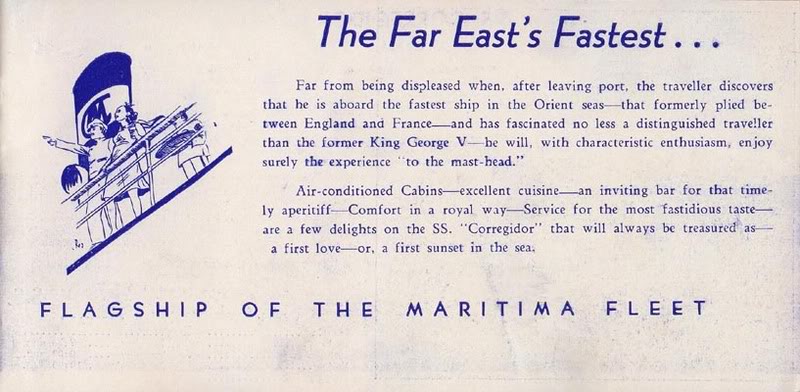The Sinking of the SS Corregidor Dec. 17 1941. 900-1,200 Lives Were Lost.
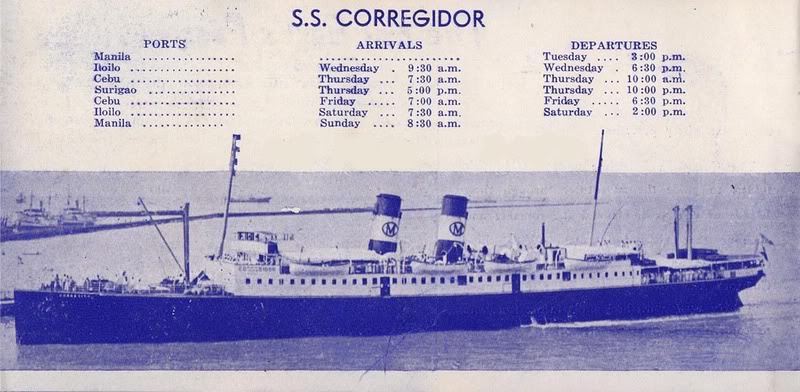
It was the fastest air-conditioned Inter-Island passenger ship during its time. It was owned by Compania Maritima, with Capt. Apolinar Calvo a veteran skipper of Spanish descent in command. It was a retired warship, a seaplane tender that saw action in the battle of the Jutland Sea during World War I. Named the HMS Engadine, Its seaplanes helped turn the tide in favor of England during the two day sea battle (31 May- 1 June 1916) against Germany. Although both sides claimed victory and the outcome of the battle tactically inconclusive; British dominance of the North Sea was maintained. After the war, the ship reverted to its “civilian status” and was later bought by Compania Maritima in 1933 and changed her name to SS Corregidor.
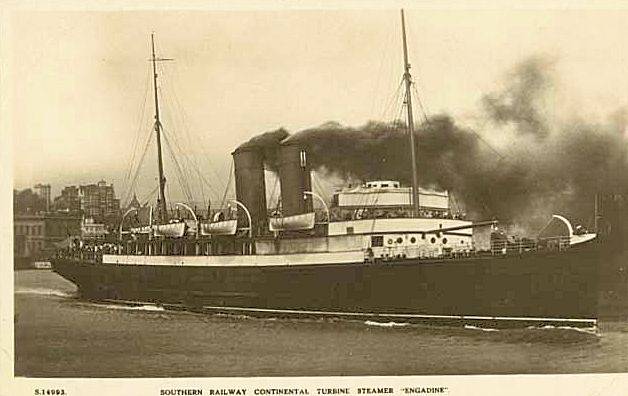
The SS Corregidor was the HMS Engandine before Compania Maritima bought her.
Not far from our family plot in a cemetery in Cagayan de Oro, I came upon a gravestone that says “Perished board S/S Corregidor at the outbreak of World War II.” I recalled my grandma Adelina “Deling” Neri Marfori’s story about this particular incident. She was a student at the University of Santo Tomas, It was Christmas break and war has just started. Most of her male friends and relatives were called to colors and were reporting to their assigned units.
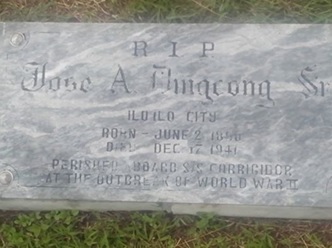
If only gravestones were marked not just with names and dates but also on how the person died, It would be an interesting read.
A daughter of a well to do physician in Cagayan de Oro, she was able to purchase a ticket for one of the ship’s air conditioned cabins days before its departure. But relatives in Manila advised her to stay put and let her young uncle, Briccio Neri Tamparong who was a senior in college and was a couple of years older to take the boat home instead. The ship, they reasoned, would be an irresistible target for Japanese torpedo planes and submarines rumored to be prowling near Manila Bay. On the morning of December 16, Olongapo was bombed again. Deling, saw it fit to stay behind.
Briccio was with his friend Jaime Frias who was a varsity swimmer and Tinong Tugot who would one day become a champion golfer from Bukidnon. Confident that they have tickets, they waited in the Pier while the ship was being loaded with its cargo in almost black out condition. When they got on board, they could hardly squeeze themselves in as the boat was jam-packed with passengers, many of whom had no ticket and were not registered on the ship’s log.
By 10:00 o’clock in the evening, The SS Corregidor left the port of Manila in blackout condition, overloaded with passengers seeking to escape to the southern Philippine islands. It has been estimated that between fifteen hundred to three thousand persons were on board, including around one hundred fifty Filipino soldiers, seven American citizens, five Filipino lawmakers, and hundreds of college students who were returning home to the provinces after their schools had closed. Also on board were military supplies as well as artillery pieces and support equipment destined for the Visayan-Mindanao Force of the Philippine Army.
Captain Apolinar Calvo, the skipper of the SS Corregidor was an experienced ship captain and had past experience in navigating the mined entrance to Manila Bay that was put in place by the US Navy since July 1941, but the Navy had changed its procedures on that fateful day. Instead of posting a gunboat near the safe channel as they had previously done, lighted buoys were instead used to act as a beacon to guide boats through. As the SS Corregidor sailed close to the island of Corregidor to pass through the channel at around one o’clock, the ship was seen moving toward the electrically-controlled minefield. The Naval officer on duty at the US Army’s Seaward Defense Command headquarters on the island upon observing the Ship’s position, asked to consider disarming the electrically controlled mines so that the SS Corregidor could pass through the minefield. A number of witnesses state that the Seaward Defense Commander, Colonel Paul Bunker ordered that the mines be kept armed.
“The Army and the Filipino skippers had long been butting heads. All the channels out of Manila Bay had been mined for many months. At this time, the mining was strictly up to date and operational. At 1 AM on 16 December, the SS Corregidor, carrying 760 refugees, attempted to go thru the minefield without asking clearance. This request would have been granted. The Lieutenant who was on watch in the mine casement, on sighting the SS Corregidor called his superior, who in turn, called the seaward defense commander, Col. Bunker, requesting information as to whether he should de-activate the contact mines in the channel. With a lifetime of experience with the Filipino, going back to the ’98 Insurrection, Col. Bunker said ‘No!’ My first knowledge of this affair came when my duty watch called me at 12:55 AM. The Corregidor had struck one of our mines and in the four or five minutes it took to reach my battery command post, the vessel had sunk. … Thereafter, we had no trouble with unauthorized Filipino boats attempting to traverse the channel” (POW Diary of Captain George Steiger)
Briccio, Jaime and Tinong were out on the deck of the SS Corregidor, It was dark but it was better than being inside the ship where it was getting hot and smelly save for the air conditioned cabins now packed with women and children. It was almost 1:00 AM when suddenly there was a loud thud followed by an explosion. The ship shuddered and was taking in water. People on board began to panic, there were not enough life belts on board and passengers who were able to secure one were still frantically putting it on while others tried to clamber on to the wooden lifeboats that were still secured to the Ship. Some tried to go back to the cabins to gather their family members when a second more terrifying explosion happened. The boys either jumped or were blown overboard and were now treading water. Briccio was able to find some flotsam that could support his body. Thick acrid smoke hung heavily in the air. Though Jaime was in his element, oil and debris hindered his efforts on helping fellow survivors, tugging at them away from the sinking ship, as it sucked in debris and passengers as it went down the bottom. It was gone within minutes. PT boats raced to the scene and were pulling survivors till dawn. It took four hours before they were finally rescued.
“On the night of December 17 there was a large explosion in Sisiman Cove. Looking out across the entrance to Manila Bay, the men of Squadron 3 could see many flashing lights on the water. Lieutenant Bulkeley immediately got PT’s 32, 34, and 35 underway. At the edge of the minefield at the entrance of the bay they found the water thick with oil and dotted with survivors of the SS Corregidor, a Filipino ship carrying evacuees from Manila to Australia. Leaving the harbor on a faulty course, the Corregidor had struck a mine and gone down almost immediately.
The PT crews rigged ladders and lines over the side, and worked until they were exhausted hauling the wet and oily passengers aboard. Not until they put the survivors ashore at Corregidor and aboard the SS Si-Kiang at Mariveles were they able to count them. When they did, they could scarcely believe the total. The three boats had picked up 296 passengers, of whom all but 7 survived. PT 32, a 77-foot boat designed to carry 2 officers and 9 men, had taken aboard, in addition to its own crew, 196 passengers from the Corregidor.” (From the book: “At Close Quarters: PT Boats in the United States Navy”)
Briccio, Jaime and Tinong made it to safety, but many were lost at sea. My grandmother Adelina, stayed in Manila during the Japanese Invasion and witnessed the bombings and numerous dogfights. Her school, Santo Tomas became a prison camp and eventually fighting ceased in the urban areas. She was able to return home to Cagayan de Oro during the Japanese Occupation on board a “batel” a large wooden inter-island ferry.
Because of the Japanese invasion. the incident was never investigated and a news blackout was instituted. Telegrams alluding to the SS Corregidor tragedy were censored, leaving the families of the victims in the dark as to what happened to their loved ones. The total number of victims is unknown and It has been estimated that 900–1,200 lost their lives owing to the body count and passengers listed on the manifest who remained missing. It was said that more than three thousand refugees boarded the doomed ship. The sinking of the SS Corregidor is considered as one of the most significant maritime accident in Philippine history, and one of the greatest maritime disaster in the world that did not happen as a consequence of military or naval action.
There are other stories about the sinking of the SS Corregidor, but the list of the victims’ names remained elusive. Perhaps some of the readers would know of somebody who died or survived the disaster could add to it.
Among the Dead:
Pablo Abigan. (Businessman)
Atanacio Ampig (Assemblyman of Iloilo)
Jose Benjamin “Bing Bing” Avila
Guillermo Buyco
Apolinar Calvo (ship captain)
Julio de la Cruz (Businessman)
Jose A. Dingcong Sr.
Gil Herbacio
Josefina Tiu – Herbacio (the Herbacio’s also lost their 3 children and a nanny)
Jose Maloco.
Jose Manalo
Jose Octavio (Businessman)
Aurelio Poblador
Juan M. Reyes (Assemblyman of Capiz)
Carmen Regis Roa (Manila Carnival Beauty Queen, Socialite from Cebu)
Edgardo Robles
Serapion Torre (former Iloilo city president)
Jesus Pablo Hermenegildo Larena Villanueva
Hermenegildo Teves Villanueva, Jr. (former Senator)
Among the survivors were :
Rafael Alianza
Felipe Andilab
Simplicio Carreon (later Mayor of Iloilo)
Raymundo Dominado
Jaime Frias (Cagayan De Oro)
Adelaida Javier
Dominador Laborte MD (City Health Officer of Iloilo)
Ester Luna
Ma. Celia Palma (later Dean of West Visayas Sate University)
Gonzalo Peñasales
Tomas Robles
Jose Romero (Assemblyman of Negros Occidental)
Decoroso Rosales (Assemblyman of Samar)
Godofredo Suarez
Dominador Tan (Assemblyman of Leyte) (lost his wife and two children)
Briccio Neri Tamparong (Cagayan De Oro)
Celestino “Tinong” Tugot (Bukidnon)
Bernabe Vellegas
Estella Villanueva (Wife of Jesus Pablo Villanueva)
Diosdado Villaruz
Calixto Zaldivar (Assemblyman of Antique)
Enrique Zamora
(I came across some of the names from the Works of Atty. Rex Salvilla and Valeriano “Bobit” Avila and some old clippings that I kept sans the name of the writer and from stories my grandma told me.
http://thedailyguardian.net/index.php/iloilo-opinion/179-panay-guerilla-vignettes-the-sinking-of-ss-corregidor
http://www.philstar.com/freeman-opinion/33765/sinking-ss-corregidor-66-years-ago
www.manilacarnivals.blogspot.com)
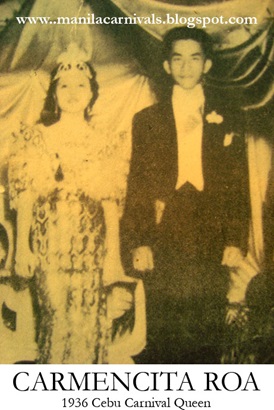
1936, CARMEN ROA y REGIS. Daughter of former governor Jose Roa, and Apolonia Regis of Carcar, Carmen was a leading high society figure of Cebu. She was to die in a sea tragedy aboard SS Corregidor, which sank in Manila Bay on December 17, 1941, just shortly after the bombing of Pearl Harbor.
